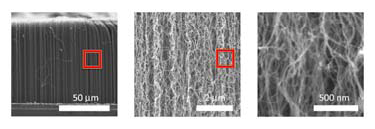Single-walled carbon nanotube films are not only mechanically flexible but they also conduct heat extremely well. This finding, from researchers at Stanford University in the US, means that the films might be used in a variety of innovative surface technologies – ranging from solar cells to waste heat recovery systems in automobiles and even smart phones and tablets.
Materials that are both mechanically flexible and that conduct heat well do not exist in Nature. However, this unusual combination of properties is crucial for making devices that are able to transfer heat between different surfaces – a metal heat sink, for example. Previous attempts to make such structures produced systems that degraded or failed over time because the interfaces between the different materials employed cracked or delaminated during thermal cycling.
A “compliant” thermal conductor would solve these problems, explains team leader Kenneth Goodson (
http://nanoheat.stanford.edu/people/kenneth-e-goodson). “We now report here on the first in-plane mechanical compliance data for SWCNT films, which we found also conduct heat as well as many metals.”
The researchers have pinpointed the exact physical mechanisms responsible for the
mechanical modulus they measured in their SWCNT films, including van der Waals forces and nanotube interactions such as zipping/unzipping and entanglement. “We measured the modulus using a MEMS technology that we developed in earlier work,” said Goodson. “Basically, we used a silicon resonator that experiences a shift in its resonant frequency when a CNT film is placed on it. This shift is due in part to the modulus of the film, which we extract from the resonant frequency data as well as from computer models.”
The team also studied its films using scanning electron microscopy to understand the relationship between how the CNTs were aligned in the films and the measured modulus. “We employed computer simulations to determine the relative contribution of the CNT unzipping (which is governed by van de Waals forces), CNT bending forces and entanglement,” Goodson told nanotechweb.org.
According to the scientists, the simulations and experiments described in their new work could help them engineer a variety of nanostructured materials based on aligned fibres and sheets that not only conduct heat well but also have the right mechanical properties. Such materials might find use in a host of energy conversion and thermal management applications – for example, cooling down portable devices.
Goodson and colleagues say that they are now busy extending their studies to metallic nanowires films and porous metal foams, both of which are resilient to high temperatures.


